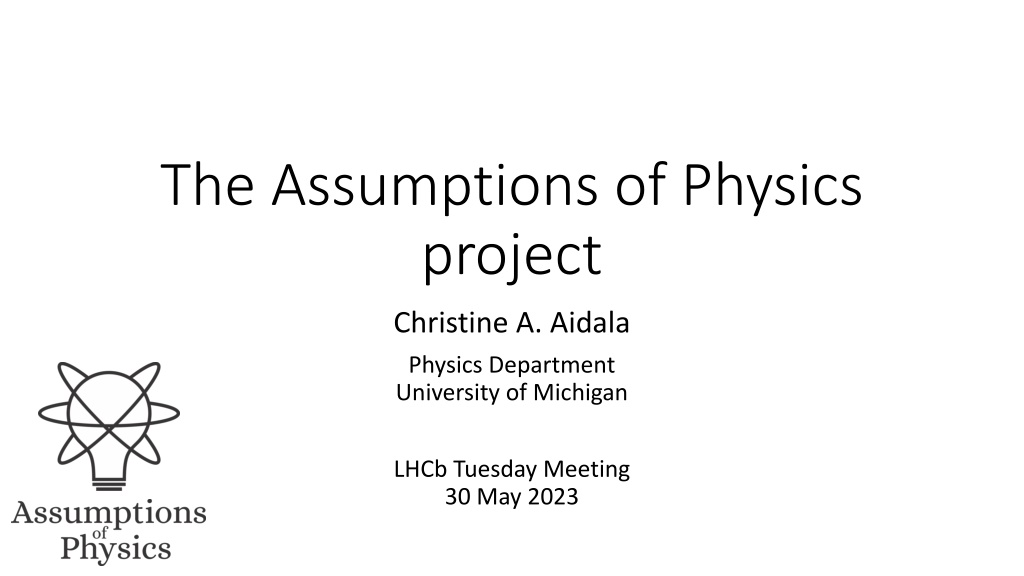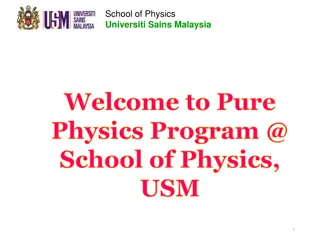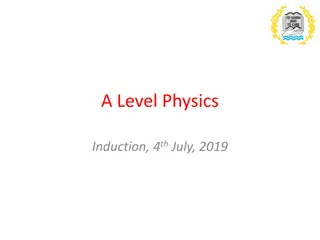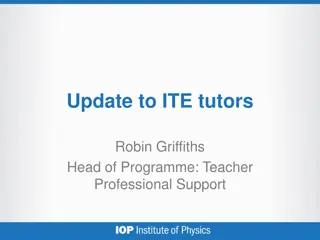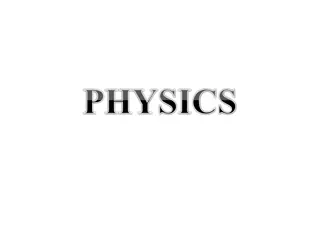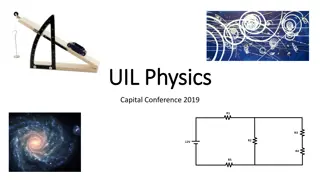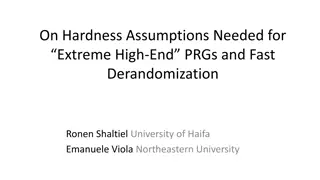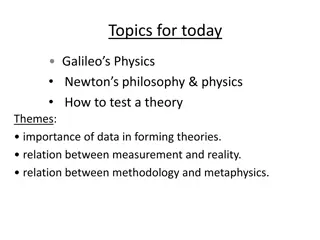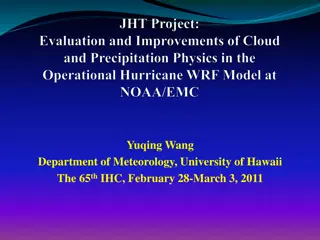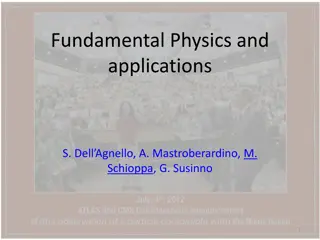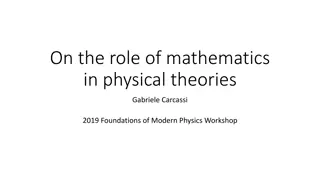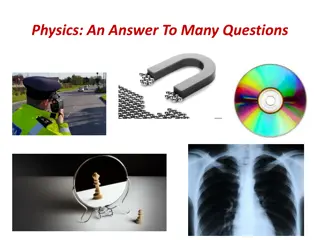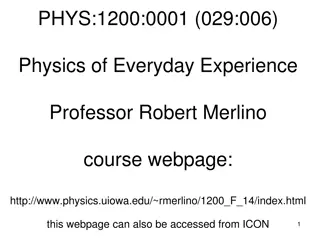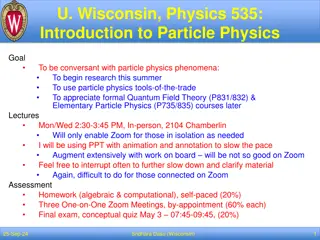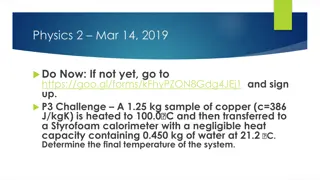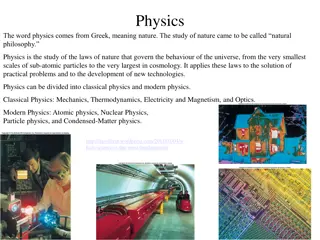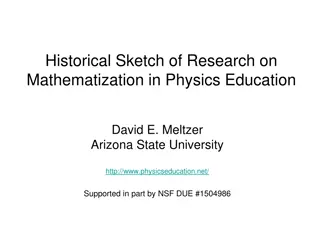The Assumptions of Physics project
Delve into a project spearheaded by Christine A. Aidala from the University of Michigan aiming to uncover minimal physical assumptions driving laws in physics. Explore reverse physics, physical mathematics, and the quest to understand the fundamental concepts underlying various physical theories.
Download Presentation

Please find below an Image/Link to download the presentation.
The content on the website is provided AS IS for your information and personal use only. It may not be sold, licensed, or shared on other websites without obtaining consent from the author.If you encounter any issues during the download, it is possible that the publisher has removed the file from their server.
You are allowed to download the files provided on this website for personal or commercial use, subject to the condition that they are used lawfully. All files are the property of their respective owners.
The content on the website is provided AS IS for your information and personal use only. It may not be sold, licensed, or shared on other websites without obtaining consent from the author.
E N D
Presentation Transcript
The Assumptions of Physics project Christine A. Aidala Physics Department University of Michigan LHCb Tuesday Meeting 30 May 2023
Introduction There has been extensive focus and effort for the last half century on developing new theories within physics, searching for beyond-the-Standard- Model physics We believe that in order to search most effectively for new physical theories, first we should better understand our various established physical theories and their mathematical structures Christine Aidala - University of Michigan 2
Lead a project called Assumptions of Physics https://assumptionsofphysics.org/ Find a set of minimal physical assumptions from which the laws can be rederived Reverse Physics: Start with the equations, reverse engineer physical assumptions/principles What are the basic concepts/idealizations behind the different physical theories? Physical Mathematics: Start from scratch and rederive everything from physical requirements Which mathematical structures (or which parts) are physical? Gabriele Carcassi - University of Michigan 3
Outline elevate the discussion from mathematical constructs to physical principles, assumptions and requirements (reverse physics) Construct a perfect map between mathematical and physical objects - Understand which mathematical structures are physical and which aren t that the current mathematical foundations are not quite what we need for physical theories (need for physical mathematics) Christine Aidala - University of Michigan 4
Reverse physics: from laws to physical assumptions Reverse Physics: From Laws to Physical Assumptions Gabriele Carcassi, Christine A. Aidala Foundations of Physics (2022) 52:40 https://arxiv.org/abs/2111.09107 Christine Aidala - University of Michigan 5
one d.o.f. Reversing classical Hamiltonian mechanics ? = ?2 Mathematically, fully characterized by an incompressible flow ??? ??= 0 = ?1 ? |?| = 1 Physically, equivalent to (1) Deterministic and reversible evolution For generalization, independence of d.o.f. s is the only additional requirement Count of states (volume) is conserved (2) Thermodynamically reversible evolution Thermodynamic entropy (log of volume) is conserved (3) Conservation of information (4) Conservation of uncertainty Determinant of covariance matrix is conserved Christine Aidala - University of Michigan 6
Reversing the principle of least action ? ? = ???? = ? ? ? ? ? = 0 ? = ? No state is lost or created as time evolves Minus sign to match convention The action is the line integral of the vector potential (unphysical) ? ? Variation of the action ? ? ? ? ?? ? = ? Gauge independent, physical! ? = ? ? ? Variation of the action measures the flow of states (physical). Variation = 0 flow of states tangent to the path. https://arxiv.org/abs/2208.06428 So far rejected without review by five journals because it is not of interest Christine Aidala - University of Michigan 7
Reverse physics: Understanding links between theories Deterministic and reversible evolution existence and conservation of energy (Hamiltonian) Why? Stronger version of the first law of thermodynamics Deterministic and reversible evolution past and future depend only on the state of the system the evolution does not depend on anything else the system is isolated First law of thermodynamics! the system conserves energy Christine Aidala - University of Michigan 8
? = ?log? Reversing the uncertainty principle Quantum mechanics has a lower bound on entropy: for a pure state, ? ? ? For a density matrix, ? ? = ?? ?log? . = 0. Take the space of all possible distributions ? ?,? and order them by information/Gibbs entropy ?0 Fix the entropy to a constant ?0 and consider all distributions with that entropy ??0 2?? ???? They satisfy ???? equality for independent Gaussians Lower bound on entropy lower bound on uncertainty Inverse does not work: lower bound on uncertainty does not give a lower bound on entropy Christine Aidala - University of Michigan 9
Reversing the uncertainty principle Lower bound for information entropy (Gibbs/von Neumann) uncertainty principle (classical/quantum) We don t need the full quantum theory to derive the uncertainty principle: only the lower bound on entropy The difference is that in classical mechanics we can prepare ensembles with arbitrarily low entropy which is actually in contradiction with the third law of thermodynamics!!! Christine Aidala - University of Michigan 10
Holistic approach Assumptions of CM Classical mechanics Statistics Measure theory Assumptions of QM Quantum mechanics Assumptions of physics Information theory Differential geometry Assumptions of TD Thermo- dynamics No single fundamental point of view (e.g. everything is information ) Foundations of different theories are not disconnected Find those conceptual clusters that span multiple areas of physics, math, Christine Aidala - University of Michigan 11
Reverse physics: Summary Reverse physics is an approach to the foundations of physics that starts from the physical laws and aims to go back to a suitable minimum number of physical assumptions The goal is to fully map conceptual relationships and dependencies between different theories, different aspects of the theories, and to help foster higher level physical reasoning It is, by its nature, an interdisciplinary endeavor, and it can allow us to think more deeply about physical ideas and their relationships Christine Aidala - University of Michigan 12
Physical mathematics: from physical requirements to mathematical structures Christine Aidala - University of Michigan 13
Physical mathematics In modern physics, mathematics is used as the foundation of our physical theories From Hossenfelder sLost in Math: [ ] finding a neat set of assumptions from which the whole theory can be derived, is often left to our colleagues in mathematical physics [ ] But mathematics only deals with formal systems, without any connection to or concern about physical reality. Formal definitions are neither necessary nor sufficient to do physics. Not useful in a lab David Hilbert: Mathematics is a game played according to certain simple rules with meaningless marks on paper. Bertrand Russell: It is essential not to discuss whether the first proposition is really true, and not to mention what the anything is, of which it is supposed to be true. Physics is defined in terms of physical objects and operational definitions. Using assumptions and approximations, physical objects and their properties are idealized. The idealized model can then be expressed in the formal system. The idealization step is the most important part of this process, and it happens outside the formal system! Christine Aidala - University of Michigan 14
Are Hilbert spaces physical? Hilbert space: complete inner product vector space Redundant on finite dimensional spaces. For infinite dimensional spaces, it allows us to construct states with infinite expectation values from states with finite expectation values Exactly captures superposition/ statistical mixing Exactly captures measurement probability/entropy of mixtures Physically required Physically required Thus requires us to include unitary transformations (i.e. change of representations and finite time evolution) that change finite expectations into infinite Extremely physically suspect!!! Suppose we require all polynomial of position and momentum to have finite expectation Maybe more physically appropriate? Schwartz space Only space closed under Fourier transform Used as starting point of theories of distributions Christine Aidala - University of Michigan 15
Differential forms increasing important tool in theoretical physics, but mathematically abstract Physical mathematics: differential forms Differential forms are fully anti-symmetric function of vectors Vector defined as derivation ?:? ? ? ? Define integral on top of forms ?:? ? ??:? ? = ?? = ? ?? ? = ?? ???? = ?? vector basis ? = ???? ? ?,? = ??????? ? Abstract definitions at points, construct finite from infinitesimal Concrete definitions on finite, infinitesimal as a limit Assume quantity is additive on disjoint regions Thinking about finite regions/values leads to better physical intuition Start with finite quantities over finite regions = ?? ?? = ? ? = ?? ?? = ??(??) = ? ? = ?? ?? ? ? ( ) Makes it clear that the mathematics is contingent upon the assumptions of additivity (if this fails, differential forms are inapplicable) ?(?) Differential forms: infinitesimal limit Christine Aidala - University of Michigan 16
Physical mathematics: Experimental verifiability as the 1st basic requirement Science deals with assertions whose truth can be defined/ascertained experimentally Verifiable statements: assertions that can be experimentally verified in a finite time The mass of the photon is less than 10 18 eV Verifiable The mass of the photon is exactly 0 eV Not verifiable due to infinite precision, but falsifiable Different logic of verifiable statements: Finite conjunction/logical AND (all tests must succeed in finite time) Countable disjunction/logical OR (once one test succeeds, we can stop) No negation/NOT (FALSE FAILURE) SUCCESS (in finite time) T UNDEFINED F FAILURE (in finite time) Note: whether a specific statement is experimentally verifiable or even well defined may depend on context (e.g. premises, idealization, theory, etc ) The mass of the electron is 511 0.1 KeV When measuring the mass, it is a verifiable hypothesis When performing particle identification, it is assumed to be true Christine Aidala - University of Michigan 17
Experimentally distinguishable cases Statements formally associated with an experimental test Theoretical statements Precise map between physical concepts and their mathematical representation Verifiable statements If true, test always succeeds in finite time Possibilities ?-algebra Borel sets All proofs can be translated into physically meaningful Points Open sets Topology language Towards a general mathematical theory of experimental science https://arxiv.org/abs/1807.07896 Christine Aidala - University of Michigan 18
The need for physical mathematics We can t expect mathematicians to provide the formal structures we need for physics they do not have enough understanding of the practical requirements of physics to create the appropriate abstractions the foundations of mathematics are not a good foundation for physics The proper foundation for physics is a conceptually consistent formal abstraction of the practice of experimental science (not of the universe ) We need to identify the formal structures that are appropriate to encode operational requirements and assumptions: physically motivated mathematics We can t do this work without a deep understanding of how formal systems work, and how we can bridge the formal and informal parts We need to understand which mathematical details to keep because they are physically relevant and which to quotient out we need a good understanding of the foundations of mathematics Christine Aidala - University of Michigan 19
Practical problems doing a project like this High level of specialization of most journals, conferences, and funding programs Even journals that claim to be general. PRL initially told us that our paper reducing the number of postulates of quantum mechanics was not of general interest. We pointed out that the first paper in the latest issue was Stochastic interpolation of sparsely sampled time series via multipoint fractional Brownian bridges, and our paper was then accepted (PRL 126, 110402, https://arxiv.org/abs/2003.11007) Many journals want to publish articles they expect to be highly cited This is not what is being discussed in mathematical physics People interested in rigorous mathematics often not interested in the physics. People interested in the physics often want to use trendy and fancy mathematical tools. Some of our work has been criticized as not mathematically sophisticated Christine Aidala - University of Michigan 20
Practical problems doing a project like this Interdisciplinary research often challenging until a new discipline is formed, e.g. biophysics Some philosophers have a strong technical background and interest in aspects of this project, but philosophy as a discipline has greater pressure for single-author papers. I don t collaborate. Standard physics curriculum doesn t typically cover fundamental mathematical tools underpinning [differential geometry, calculus?], i.e. topologies, sigma-algebras, measure theory, []. People working on foundations of quantum mechanics often never studied the mathematical structures of classical mechanics or those underpinning probability and information theory Theoretical physicists working on beyond-the-SM physics not asking questions such as What conditions allow me to use a metric? to use a manifold? Need space for a small, technical community working on these types of foundational issues, in a spirit similar to the international metrology community Christine Aidala - University of Michigan 21
Conclusions The solution to many open problems in the foundation of physics lies in a better understanding of the current mathematical tools, their physical meaning and the development of fundamentally new tools Reverse physicshelps us reframe the current theories in terms of physical requirements and assumptions, shifting the attention away from math to physical ideas Physical mathematicshelps us understand clearly how physical ideas are encoded into the formal systems, and find physically motivated generalizations We need to leave space within physics for this type of foundational work! Christine Aidala - University of Michigan 22
Supplemental Christine Aidala - University of Michigan 23
Reverse Physics Physics Smallest set of assumptions required to rederive the theory Physical result/ effect/prediction Physical theory Reverse Mathematics Mathematics Smallest set of axioms required to prove the theorem Mathematical result/ corollary/calculation Theorem Christine Aidala - University of Michigan 24
(5) Deterministic and thermodynamically reversible evolution ? = ?2 = ?1 ? Link between statistical mechanics and thermodynamics ? = ??log? Area conservation entropy conservation thermodynamically reversible evolution Christine Aidala - University of Michigan 25
(6) Information conservation ? = ?2 = ?1 ? What about information entropy? ? ?(?,?) = ?log????? ? ? ? + ?? = ? ? ? ?log|?|???? Area conservation information conservation Christine Aidala - University of Michigan 26
(7) Uncertainty conservation ? = ?2 = ?1 ? covariance matrix What about uncertainty? ??2 ????,? ?? = 2 ????,? Assuming a very narrow distribution ? + ?? = ? ? ? Area conservation uncertainty conservation Christine Aidala - University of Michigan 27
Three fundamental assumptions in Classical Mech Infinitesimal Reducibility (IR) Determinism/Reversibility (D/R) Kinematic Equivalence (KE) IR Classical phase space (symplectic manifolds unit independent state count/densities/information entropy/thermodynamic entropy) IR+Directional degree of freedom Space has three dimensions (2-sphere only symplectic manifold) IR+Directional degree of freedom Classical analog for non-relativistic spin (open problem: relativistic analog) IR+D/R Hamiltonian mechanics (Hamiltonian flow conservation of state count/density/information entropy/thermodynamic entropy/dof independence) IR+D/R energy-momentum co-vector, energy/Hamiltonian time component (pre-relativistic aspects w/o proper notion of space-time) IR+D/R change of time variable changes the effective mass (similar to relativistic mass rest mass scaled by time dilation) IR+D/R classical antiparticles (w/o field theory, without quantum theory or full relativity/metric tensor) IR+D/R classical uncertainty principle (uncertainty bound during evolution) IR+D/R stationary action principle (with physical/geometrical interpretation, but w/o Lagrangian) IR+D/R+KE Massive particles under scalar and vector potential forces IR+D/R+KE ??? is Poisson bracket between kinetic momenta; metric tensor as a geometrical feature of the tangent bundle (?????????); mass counts states per unit velocity; metric tensor locally flat (open problem: what about curvature?); speed of light converts count of possible time instants into number of possible spatial positions (i.e. ratio of measures, not speed). IR+D/R Hamiltonian mechanics (HM); IR+KE Newtonian mechanics (NM); IR+D/R+KE Lagrangian mechanics (LM); LM = HM NM HM NM LM Christine Aidala - University of Michigan 28
continuum discrete Quantifying discrete cases is fundamentally different than quantifying cases over the continuum finite measure zero measure Why? Because fully identifying a discrete case requires finite information (finitely many experimental tests) while identifying a case from a continuum requires infinite information (an infinite sequence of increasingly precise tests) This is something most physicists haven t yet fully digested Christine Aidala - University of Michigan 29
continuum discrete A single classical state in phase space (i.e. a microstate) zero volume; minus infinite entropy; infinite information. finite measure zero measure Empty state one discrete case; zero entropy; finite information. quantum: continuum with points of finite measure Quantum mechanics fixes this, by introducing a fixed lower bound on entropy. Christine Aidala - University of Michigan 30
New insights lead to new ideas Christine Aidala - University of Michigan 31
Measure theory plays a foundational role for theories of integration (e.g. geometrical sizes), probability and information theory: common physically motivated underpinning? Consider the following statements: The position of the object is between 0 and 1 meters The position of the object is between 2 and 3 kilometers The fair die landed on 1 The fair die landed on 3 or 4 The first bit is 0 and the second bit is 1 The third bit is 0 and and and In all three cases, the first statement is more precise , it is of a finer granularity (noted ) Constraining to a smaller volume gives finer description Less likely events give more information Statements with more information give a finer description Comparing statements based on their granularity is another fundamental feature a physical theory must have Christine Aidala - University of Michigan 32
We need a generalized version of measure theory that covers all cases Some statements are incomparable: The position of the object is between 0 and 1 meters vs The velocity of the object is between 2 and 3 meters per seconds ? ? Comparability cannot be captured by a single measure: ? ?,? ? ? while ? ? ? ?,? ? ? ? Entropy in quantum mechanics is consistent with first two requirements Quantization breaks additivity: Single point is a single case (i.e. ? ? Finite range carries finite information (i.e. ? ? < ) Measure is additive for disjoint sets (i.e. ? ?? = ? ??) ? = 1) ? From what we understand, this is new mathematics Christine Aidala - University of Michigan 33
What could a generalized measure theory be useful for? In a field theory, the value at each point is an independent d.o.f. Measure of the volume counts the independent d.o.f. Yet, in a singularity this can t be the case: value of the field at each point loses meaning; Information encoded on the surface (holographic principle) Flat space, zero curvature, measure factorizes (i.e. ? = ? ? ?) Singularity, infinite curvature, volume flattens ? ? ? ? ? ? ? ? Christine Aidala - University of Michigan 34
What could a generalized measure theory be useful for? In a field theory, the value at each point is an independent d.o.f. Measure of the volume counts the independent d.o.f. Is the curvature an indicator for how independent the values of the fields are? Does quantizing space-time mean using a non-additive measure, so that the count of d.o.f. does not go to zero (but to a finite measure)? Flat space, zero curvature, measure factorizes (i.e. ? = ? ? ?) Singularity, infinite curvature, volume flattens ? ? ? ? ? ? ? ? Christine Aidala - University of Michigan 35
Need a generalized theory of physical systems codefined State space Processes State space must always be equipped with the processes under which the system is defined Consistency requirements: state symmetries processes open sets; system decoupling process symmetries; measurement measure (and entropy) defined on states; Christine Aidala - University of Michigan 36
